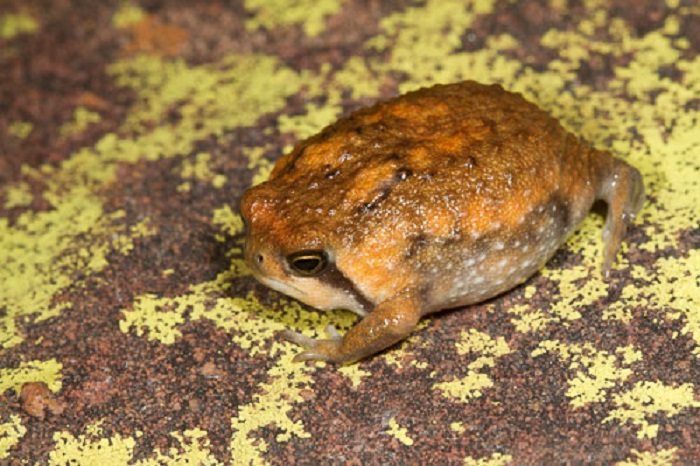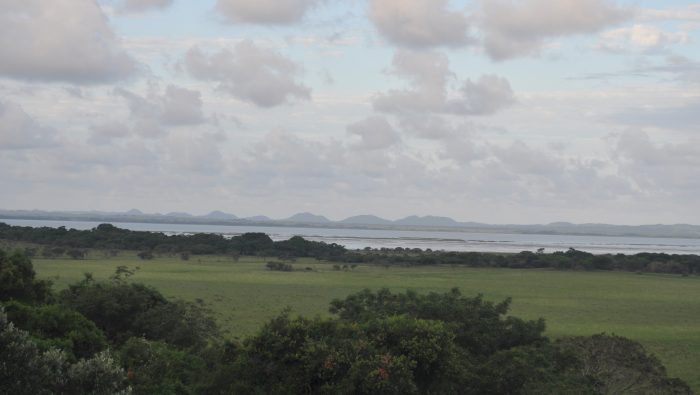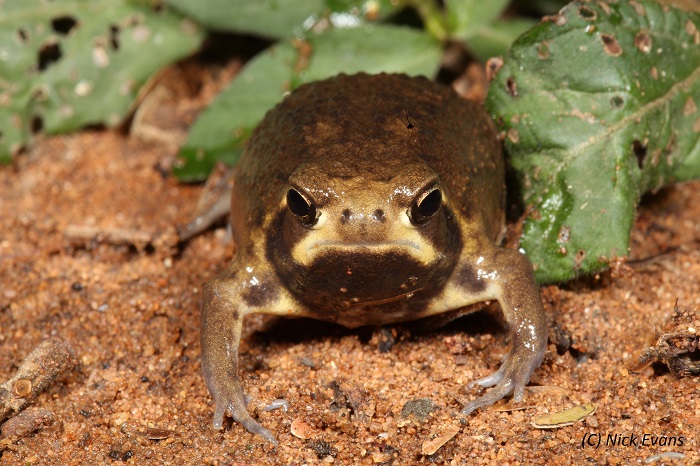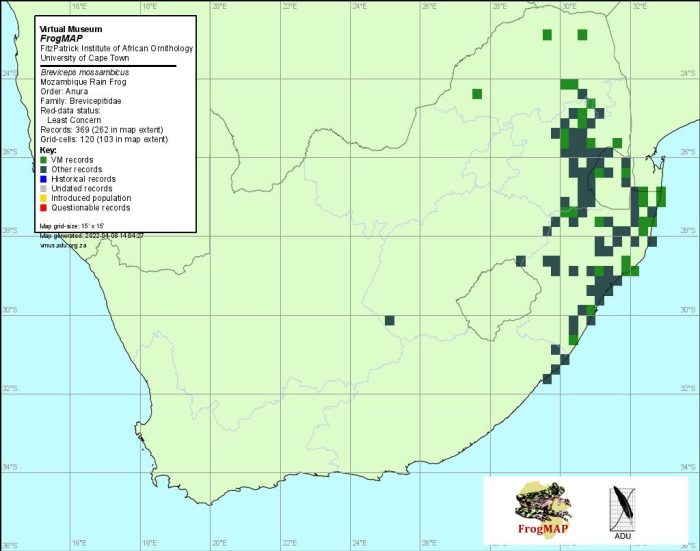Cover photo by Heather Hodgson.
Find the Mozambique Rain Frog in the FBIS database (Freshwater Biodiversity Information System) here.
Family Brevicepitidae
Identification
The Mozambique Rain Frog attains a maximum length of 52mm. Females are larger than males. The body is rotund with short legs and small eyes.
In the atlas region, the Mozambique Rain Frog exhibits considerable intra- and inter-population variation in colour and markings. Most individuals have light paravertebral and dorsolateral patches (see illustrations in Passmore and Carruthers 1995) differing, in this respect, from the northern Mozambique populations of the species. Due to the presence of similar markings in B. sopranus, B. bagginsi and B. adspersus, this character is of little diagnostic value. This weakens the assertion, based mainly on the presence, absence or extent of dorsal markings (Poynton 1964; Poynton and Broadley 1985a; Lambiris 1989a), that mossambicus and adspersus hybridise extensively in sympatry. In addition, a study of advertisement call structure found little evidence of hybridisation between these species (Minter 1998). At present, these species are morphologically indistinguishable, and identification should be based on advertisement call structure.

Marakele National Park, Limpopo
Photo by A. Coetzer
Habitat
The Mozambique Rain Frog inhabits parts of the Savanna and Grassland biomes where the annual rainfall exceeds 700 mm per year. Coastal populations of B. mossambicus in KwaZulu-Natal and the Eastern Cape inhabit well-drained, sandy soils in Coastal Bushveld-Grassland, Coast-Hinterland Bushveld and Natal Lowveld Bushveld. At higher altitudes, this species occurs along the crest and slopes of the escarpment; vegetation types include Moist Sandy Highveld Grassland, Moist Upland Grassland, Short Mistbelt Grassland, and North-eastern Mountain Grassland. The soil is usually shallow, well drained, humus-rich, and often rocky.

Western Shores, iSimangaliso Wetland Park, KwaZulu-Natal.
Photo by Ryan Tippett
Behaviour
The Mozambique Rain Frog breeds mostly in spring or early summer after soaking rains, although strong choruses sometimes form after rain at other times of the year (pers. obs.). Dry periods are spent below the surface, often under rocks or next to the foundations of walls, where soil moisture levels are higher (Minter 1997). In overcast or misty conditions, calling may continue unchecked for several days and nights (Minter 1998). Calling activity is also influenced by temperature: the chorus intensity usually drops in the early hours of the morning when temperatures are low, but increases again after sunrise, and persists until mid-morning, even on clear, hot days (pers. obs.). During the day, calling usually takes place from well-concealed, shallow depressions, but at night males often move about on the surface, calling from one location for a while before moving to another (Minter 1997, 1998).

Near Hluhluwe, KwaZulu-Natal
Photo by Nick Evans
Amplexus is by adhesion and oviposition takes place in a chamber below the soil surface. Nests excavated near Wakkerstroom were located below loose rocks on the hill slopes or under old, dry tree trunks. Females remained in the vicinity of the nests, which contained 20–25 eggs; metamorphosis was completed after 6–8 weeks (FitzSimons and Van Dam 1929; Swanepoel 1970).
After good rains, adults often emerge in large numbers from their places of concealment, to feed on alate termites (pers. obs.). At such times, many are killed on the roads.
Status and Conservation
The Mozambique Rain Frog is widely distributed in a variety of habitats and does not appear to be at risk. It occurs in a number of provincial nature reserves and national parks.
Distribution
The extralimital distribution of B. mossambicus includes southern Tanzania, Malawi, Mozambique, Zambia, Zimbabwe, and eastern Botswana (Poynton and Broadley 1985a). In the atlas region, the Mozambique Rain Frog occurs on the coastal plain of KwaZulu-Natal, extending southward as far as Mkambati (3129DA) in Eastern Cape Province. In the interior it is found in the foothills and along the crest of the Lebombo Mountains and the Great Escarpment of KwaZulu-Natal, Swaziland, Mpumalanga and Limpopo Province, extending northward as far as Haenertsburg (2329DD). The populations along the escarpment, for example, those near Wakkerstroom (2730AD), referred to B. adspersus pentheri by Poynton (1964), were assigned to B. mossambicus on the basis of advertisement call structure (Minter 1998).

The atlas data are based largely on advertisement calls and associated specimens and are considered to be reliable (Minter 1998).
Further Resources
The use of photographs by A. Coetzer, Heather Hodgson, and Nick Evans is acknowledged
Mozambique Rain Frog Breviceps mossambicus Peters, 1854
Other Common Names: Mosambiekse Reënpadda (Afrikaans)
Recommended citation format: Minter, LR; Tippett, RM. (2025). Mozambique Rain Frog Breviceps mossambicus. Biodiversity and Development Institute, Cape Town. Available online at https://thebdi.org/2021/12/16/mozambique-rain-frog-breviceps-mossambicus/
This species text has been updated and expanded from the text in the
2004 frog atlas: Minter, LR. (2004). Mozambique Rain Frog Breviceps mossambicus. In Minter LR et al 2004.
References:
Minter, LR; Burger, M; Harrison, JA; Braack, HH; Bishop, PJ; Kloepfer, D. (Editors). (2004). Atlas and Red Data Book of the Frogs of South Africa, Lesotho and Swaziland. Smithsonian Institution, Washington, and Avian Demography
Unit, Cape Town.
Carruthers, V; du Preez, L. (2017). Frogs of southern Africa: A Complete Guide. Struik Nature, Cape Town.
Channing, A. (2001) Amphibians of Central and Southern Africa. Protea Book House, Pretoria
Claus, B; Claus, R. (2002). Common Amphibians and Reptiles of Botswana. Gamsberg Macmillan, Windhoek.

